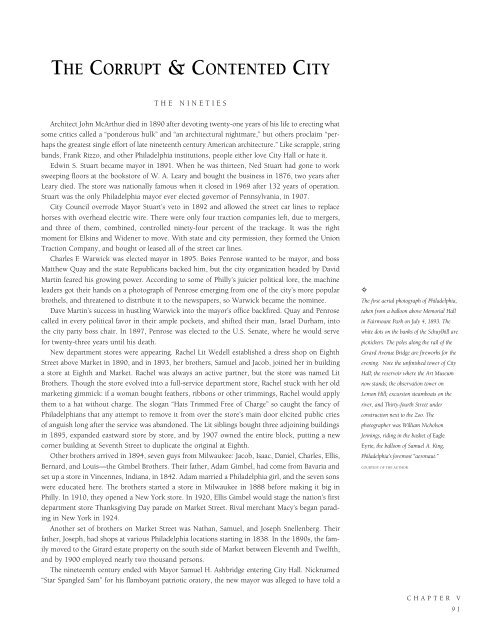Historic Philadelphia
An illustrated history of the city of Philadelphia, paired with the histories of companies, families and organizations that make the region great.
An illustrated history of the city of Philadelphia, paired with the histories of companies, families and organizations that make the region great.
Create successful ePaper yourself
Turn your PDF publications into a flip-book with our unique Google optimized e-Paper software.
THE CORRUPT & CONTENTED CITY<br />
THE<br />
NINETIES<br />
Architect John McArthur died in 1890 after devoting twenty-one years of his life to erecting what<br />
some critics called a “ponderous hulk” and “an architectural nightmare,” but others proclaim “perhaps<br />
the greatest single effort of late nineteenth century American architecture.” Like scrapple, string<br />
bands, Frank Rizzo, and other <strong>Philadelphia</strong> institutions, people either love City Hall or hate it.<br />
Edwin S. Stuart became mayor in 1891. When he was thirteen, Ned Stuart had gone to work<br />
sweeping floors at the bookstore of W. A. Leary and bought the business in 1876, two years after<br />
Leary died. The store was nationally famous when it closed in 1969 after 132 years of operation.<br />
Stuart was the only <strong>Philadelphia</strong> mayor ever elected governor of Pennsylvania, in 1907.<br />
City Council overrode Mayor Stuart’s veto in 1892 and allowed the street car lines to replace<br />
horses with overhead electric wire. There were only four traction companies left, due to mergers,<br />
and three of them, combined, controlled ninety-four percent of the trackage. It was the right<br />
moment for Elkins and Widener to move. With state and city permission, they formed the Union<br />
Traction Company, and bought or leased all of the street car lines.<br />
Charles F. Warwick was elected mayor in 1895. Boies Penrose wanted to be mayor, and boss<br />
Matthew Quay and the state Republicans backed him, but the city organization headed by David<br />
Martin feared his growing power. According to some of Philly’s juicier political lore, the machine<br />
leaders got their hands on a photograph of Penrose emerging from one of the city’s more popular<br />
brothels, and threatened to distribute it to the newspapers, so Warwick became the nominee.<br />
Dave Martin’s success in hustling Warwick into the mayor’s office backfired. Quay and Penrose<br />
called in every political favor in their ample pockets, and shifted their man, Israel Durham, into<br />
the city party boss chair. In 1897, Penrose was elected to the U.S. Senate, where he would serve<br />
for twenty-three years until his death.<br />
New department stores were appearing. Rachel Lit Wedell established a dress shop on Eighth<br />
Street above Market in 1890, and in 1893, her brothers, Samuel and Jacob, joined her in building<br />
a store at Eighth and Market. Rachel was always an active partner, but the store was named Lit<br />
Brothers. Though the store evolved into a full-service department store, Rachel stuck with her old<br />
marketing gimmick: if a woman bought feathers, ribbons or other trimmings, Rachel would apply<br />
them to a hat without charge. The slogan “Hats Trimmed Free of Charge” so caught the fancy of<br />
<strong>Philadelphia</strong>ns that any attempt to remove it from over the store’s main door elicited public cries<br />
of anguish long after the service was abandoned. The Lit siblings bought three adjoining buildings<br />
in 1895, expanded eastward store by store, and by 1907 owned the entire block, putting a new<br />
corner building at Seventh Street to duplicate the original at Eighth.<br />
Other brothers arrived in 1894, seven guys from Milwaukee: Jacob, Isaac, Daniel, Charles, Ellis,<br />
Bernard, and Louis—the Gimbel Brothers. Their father, Adam Gimbel, had come from Bavaria and<br />
set up a store in Vincennes, Indiana, in 1842. Adam married a <strong>Philadelphia</strong> girl, and the seven sons<br />
were educated here. The brothers started a store in Milwaukee in 1888 before making it big in<br />
Philly. In 1910, they opened a New York store. In 1920, Ellis Gimbel would stage the nation’s first<br />
department store Thanksgiving Day parade on Market Street. Rival merchant Macy’s began parading<br />
in New York in 1924.<br />
Another set of brothers on Market Street was Nathan, Samuel, and Joseph Snellenberg. Their<br />
father, Joseph, had shops at various <strong>Philadelphia</strong> locations starting in 1838. In the 1890s, the family<br />
moved to the Girard estate property on the south side of Market between Eleventh and Twelfth,<br />
and by 1900 employed nearly two thousand persons.<br />
The nineteenth century ended with Mayor Samuel H. Ashbridge entering City Hall. Nicknamed<br />
“Star Spangled Sam” for his flamboyant patriotic oratory, the new mayor was alleged to have told a<br />
✧<br />
The first aerial photograph of <strong>Philadelphia</strong>,<br />
taken from a balloon above Memorial Hall<br />
in Fairmount Park on July 4, 1893. The<br />
white dots on the banks of the Schuylkill are<br />
picnickers. The poles along the rail of the<br />
Girard Avenue Bridge are fireworks for the<br />
evening. Note the unfinished tower of City<br />
Hall; the reservoir where the Art Museum<br />
now stands; the observation tower on<br />
Lemon Hill; excursion steamboats on the<br />
river, and Thirty-fourth Street under<br />
construction next to the Zoo. The<br />
photographer was William Nicholson<br />
Jennings, riding in the basket of Eagle<br />
Eyrie, the balloon of Samuel A. King,<br />
<strong>Philadelphia</strong>’s foremost “aeronaut.”<br />
COURTESY OF THE AUTHOR.<br />
CHAPTER V<br />
91
















